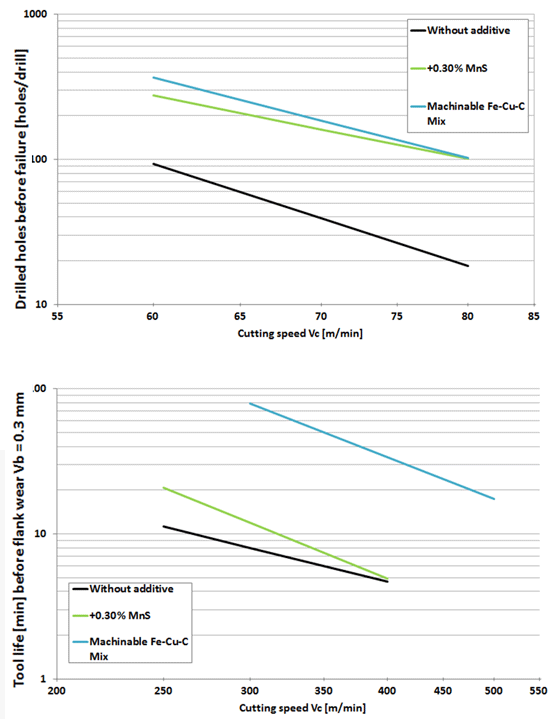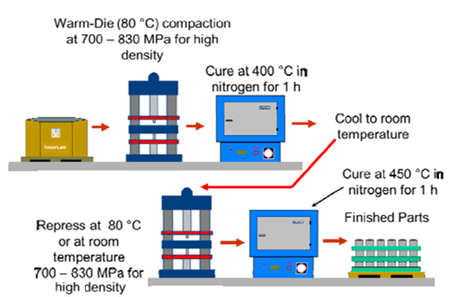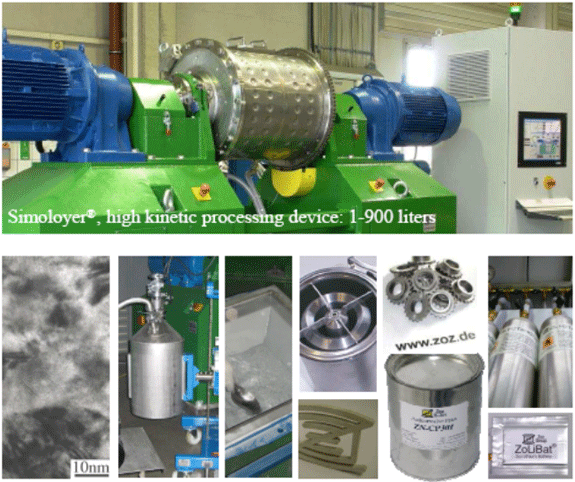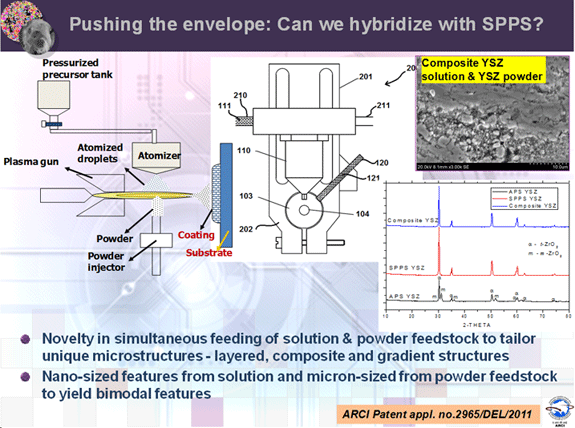PM-13 India: Developments in powders and processing
Höganäs AB
During PM-13 Höganäs presented several papers related to the development and uses of its machinable Fe-Cu-C mix. The usual machining aid MnS is suspected to form agglomerate in presence of moisture and can cause rust in the product. The solution to the region specific problem is found in the form of Fe Cu C mix which required no addition of MnS but still produced a part with good machinability.
The powders are produced by a combination of the right scrap, strict melt control techniques and by optimisation of atomisation and subsequent annealing parameters. The method of storing the ingredients, time of mixing, speed of mixing, atmosphere in the mixer, loading and unloading methods are some of the parameters that were studied and optimised. These parameters were also found to be sensitive to the location where the mixes are produced. The machinability tests showed the benefits of using Fe-Cu-C mix.

Fig. 1 Top: Drilling machinability – AHC100.29 + 2%Cu + 0.8%C
Drilling parameters: Drill Ø3.5 A002, feed f = 0.06 mm/rev, cutting depth ap = 9.6 mm (blind), dry
Bottom: Turning machinability – AHC100.29 + 2%Cu + 0.8%C
Turning parameters: Insert grade GC4215, feed f = 0.1mm/rev, cutting depth ap = 0.4 mm, dry
(Courtesy Höganäs AB)
Pometon S.p.A
Ilaria Rampin, Pometon S.p.A., Italy, stated that the volatility of the price of raw materials, as well as the European Community regulations related to Ni and Cu, had forced Pometon to find leaner alternatives to current ferrous alloys for structural applications. Two strategies were pursued, either optimisation of the content of traditional alloying elements or the introduction of Mn through proprietary alloying techniques.
Ni-Cu-Mo diffusion bonded iron powder was used as base powder and mixed with 3 different levels of Mn (0,65-0,85-1,05%) together with 3 levels of graphite (0,4-0,6-0,8%) and with 0,8% lubricant. Specimens made from these powders were sintered at 1120°C, 25 min under 86N2-12H2-2CH4 atmosphere. Half of the specimens with final sintered density 7,00 ± 0,02 g/cm3 were tested in the as-sintered condition, while, the other half after 1h tempering in air at 200°C.
It was found that the elimination of Ni, while feasible from the hardness, dimensional change and strength points of view, would inevitably bring down toughness substantially. The best composition that reaches and improves the current Diffusion-Bonded material properties is found to have 0,5%Mo – 0,7% Ni – 0,85% Cu and 0,85% Mn, stated Rampin.
Hoeganaes Corporation & GKN Sinter Metals
Brian W James and Kalathur S Narasimhan of Hoeganaes Corporation, USA, and Narsi Chandrachud of GKN Sinter Metals, Pune, compared the hardenability response of Iron base prealloyed with 0.6% Mo (FL- 4205), Iron base diffusion alloyed with 0.5% Ni- 0.5% Mo (FD- 0105) and admixed hybrid powders.
It was found that prealloyed powder has a greater effect on hardenability than the same amount of that element that is diffusion alloyed or admixed. In lean alloy compositions, diffusion alloyed powders are suitable only for relatively small PM parts if the parts are to be subsequently heat treated. Hybrid alloys based on prealloyed powders that have molybdenum as their principal alloy addition provided flexibility.
The appropriate level of molybdenum may be selected according to the size of the PM part. Higher sintering temperatures and longer sintering times improved the hardenability of diffusion-alloyed and elementally admixed powders.
Iron powder usage in electromagnetic applications has gained wider acceptance to replace ferrites operating at higher frequencies and lamination steels operating at lower frequencies. Kalathur S Narasimhan, Michael L Marucci and Francis Hanejko, Hoeganaes Corporation, USA in their presentation on ‘Effect of Particle Size and 2P2C Technology on the Soft Magnetic Properties of Composite Iron Compacts’ studied in detail the effect of particle size distribution of screened pure iron powder on induction, permeability, coreless and Q factor.
For applications of soft magnetic materials replacing lamination steels in motors and actuators the typical median particle size used is found to be 140 microns that can be processed to produce components with acceptable levels of induction and permeability. A process route called 2P2C that that allows for compaction of composite iron compacts to densities greater than 7.45 g/cm3 thus increasing the composites’ strength and magnetic performance was outlined.
Zoz Group
This year’s Fellow of PMAI (FPMAI) recipient, Prof. Dr. Henning Zoz, Zoz Group, Germany, presented a wide variety of applications for ultra fine and nano powders. The top priority, according to Zoz, is the materials requirement to convert, to store and to transport energy from alternate energy sources. However, materials consumption contradicts with limited resources, thus making recycling to be the other ultimate goal.
Both requirements lead to advanced materials processing with the utilization of larger surface and finer structures created using the company’s Simoloyer® “nanostructure-making-equipment”.
Detailed examples were given, including the development of the first public foot bridge using nanostructured high performance, high strength cement by Zoz/ Dyckerhoff. Zoz discussed Zentallium®, the groups super light-weight material stated as being half the cost of Titanium and made by pressing, sintering and hot extrusion. He also discussed Hydrolium®/H2Tank2Go® hydrogen storage systems and the H2-On Air project with EADS, Airbus, IFB etal.
International Advanced Research Centre for Powder Metallurgy and New Materials
Shrikant V Joshi and G Sivakumar, International Advanced Research Centre for Powder Metallurgy and New Materials, India, discussed in detail the application of powders, suspensions and solution precursors to coat and engineer surfaces. This, stated the authors, will help to combat premature degradation of industrial components due to surface-related degradation modes such as wear, corrosion, oxidation, high heat flux etc.
Among the large portfolio of surfacing technologies that are available today, the use of different thermal spray variants has particularly proliferated in diverse industry segments by virtue of their ability to improve component performance, reliability and longevity through appropriate tailoring of coatings as demanded by any given application. The past few years has focused on depositing nanostructured coatings to further improve engineering properties. The use of nanostructured feedstock has been widely explored, with the earliest approach involving spraying conventional micron-sized spray grade powders comprising of agglomerated nano particles.
The relatively low temperatures and short residence times in Detonation Spray Coating (DSC) and High-Velocity Oxy-Fuel (HVOF) spray techniques, unlike in conventional atmospheric plasma spraying (APS), appear to offer significant promise for retaining the nanostructure in the starting feedstock. The advent of Cold Gas Dynamic Spraying (CGDS), characterised by maximum gas temperatures below about 600°C, has opened new vistas especially for metallic coatings.
The more recent efforts aimed at obtaining nanostructured coatings by the plasma spray route have consisted of either (a) introducing the materials to be sprayed in the form of a suspension of fine particles in a liquid (usually water or alcohol), which is fragmented and vapourised in the plasma plume, as in solution plasma spraying (SPS), or (b) spraying a solution of an appropriate liquid precursor so that gelation and pyrolysis occur in situ, as in solution precursor plasma spraying (SPPS).
Both SPS and SPPS were shown to hold promise to yield nanostructured coatings with superior properties as well as coatings with new chemistry, by virtue of molecular level mixing possible in solutions. The presentation discussed recent advances in the above thermal spray approaches and particularly illustrated resulting improvements in coating attributes. Apart from comparing the benefits of these methods, results from the authors’ laboratory, which is equipped with all the above techniques, were discussed.
News | Articles | Market reviews | Search directory | Subscribe to e-newsletter








